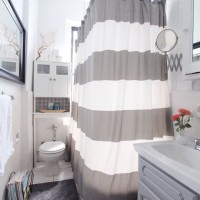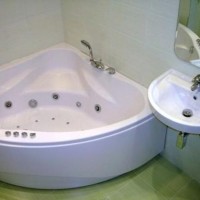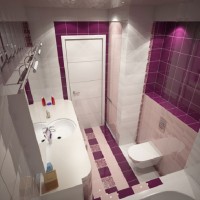Small bathrooms: design with photos in the apartment and house
The history of bathrooms began many centuries ago in the East, we should thank the eastern countries for the first water supply and sewage systems. Even the ancient Romans considered body care an integral part of life, giving a person health and longevity. Now square meters of living space are struggling with the footage of the bathroom, and in almost every apartment, the bathrooms are small. But even small bathrooms can be stylish and comfortable, most importantly, develop a functional designprove it photo in the apartment, where the bathroom was renovated according to projects that take into account the characteristics of the room.
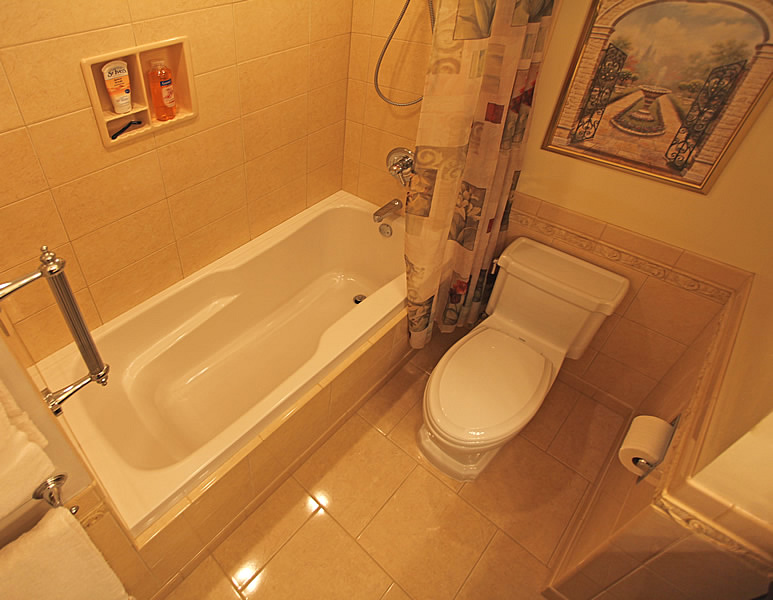
20
Content
Fighting Square and Design
Not only in our country is the acute problem of small bathrooms. In different countries, designers develop concepts to combat this unpleasant phenomenon, for example, laconic Japanese people rely on strict geometric lines, adding volume to the room, and Europeans “play” with bright details and light sources. Italian designers bring mosaics to the interior design with original patterns and ornaments, and their American counterparts put emphasis on optimizing space and functionality.

Laconic Japanese rely on strict geometric lines, giving volume to the room, while Europeans “play” with bright details and light sources.
But they all come to a common decision that in a small area it’s not worth combining several styles, just select one, having carefully worked out the details, textures and colors. The main emphasis in such a bathroom will be the emphasis on functionality.

19
Visual extension
The first problem of such a bathroom will be the lack of space, you can only increase the space visually by raising the ceiling, expanding the walls, leading the room to a square shape. What techniques are recommended for this?

18
Tip: To blur the boundaries between the ceiling and the surface of the walls, it is recommended to use painting surfaces in a single color or laying mosaics on all surfaces of the room. Round ceiling moldings, glossy surfaces and mirrors will raise the ceiling. Even mirrored ceilings in bathrooms are used for this role, but their disadvantage is the difficulty in maintaining.

The main emphasis in such a bathroom will be the emphasis on functionality.
The same effect is obtained when laying ceramic tiles from the floor to the ceiling without interruptions with borders or decorative inserts. In Europe, for this purpose, interior designers use vertical stripes made with paint or ceramic tiles.
Bright colors, violation of proportions by borders, partitions, on the contrary, visually turn a cramped bathroom into a pantry, and light pastel colors add airiness to the space. In the absence of windows, the situation will be corrected by imitation with photo wallpaper or LED backlight.

17
Work with color
The small area of the bathroom does not endure chaos in details and color accents. A thoughtful and systematic combination of colors and shades is recommended here. The best option for design is minimalism. If Japanese motives and ornaments are taken as the basis, then it is better to do them in pastel colors.For classic or oriental room design, cool colors are suitable with a combination of mosaic inserts.

The small area of the bathroom does not endure chaos in details and color accents
Dark colors, an abundance of bright details are best left for a bathroom with a large area. According to psychologists, a good range for the design of such a room is blue-blue. It will allow you to physically and mentally relax, gather your thoughts, relieve the stress accumulated over the day.

16
Tip: It is not recommended to use large patterns and accents in the interior, this will make the room visually even smaller and overload with details. You should not use more than three colors in the design of the room.
Equipping a bathroom
Many owners of tiny rooms face a shower or bath? Small bathrooms in some way limit the scope fordesignbut photos in apartments show that with the right approach, they can accommodate much more than it seems at first glance.

13
- If you do not regularly use the bath, lying in a fragrant foam, then you should choose a shower, then you can install a washing machine in the vacated space. But the bath can also be selected in a convenient streamlined shape, which will not be bulky in a small area of the room.

12
- Often the owners of small rooms refuse additional furniture modules due to lack of space. The most common methods are replacing the bathroom with a shower, refusing to install a sink. At the same time, detergents and powders stand all over the room, find their place in the bathtub or behind the toilet, which is impractical and inconvenient. The lack of space is not a reason to give up comfort and coziness.

The lack of space is not a reason to give up comfort and coziness.
- When making a shower zone, it is recommended not to put a glass partition, it is better to limit yourself to a synthetic curtain. Plumbing of the current generation is not bulky cabinets and square sinks, but rounded shapes, compact toilets and bidets. A small washbasin will save space and will not interfere with a comfortable shower. Transformer models, such as folding showers and sinks, have been developed for small areas. They have a cost higher than conventional plumbing, but are more functional and convenient.

11
- In such bathrooms, it is recommended to use built-in furniture to help avoid unnecessary piles, shelves and partitions. In small rooms, it is important to use every inch of space, for example, placing the washing machine under the sink or hanging towels on the door to the room.

1
Accessories: to be or not to be
The last step in the arrangement of the premises is the purchase of accessories. Are they appropriate in the bathroom? Yes, of course, without them, any room will become boring and faceless.

10
- The most important detail in the room will be a mirror. The stores have special mirrors that save space already with built-in lights. Such mirrors often have built-in shelves or a cabinet for storing personal hygiene products. Due to the abundance of moisture and condensation, the mirrors often fog up, so manufacturers replenish their lines with mirrors with special coatings. Such coatings prevent exposure to moisture on the surface. Such mirrors are more expensive than those made without protection, but have a long service life.

9
- After washing the body, not every one of us wants to step on a cool floor tile. To prevent this from happening, a soft mat should lie under your feet. It should be combined with the rest of the room style, fitting into the interior. A convenient option is a rubberized rug of high quality, which does not slip and retains its appearance after washing.

The most important detail in the room will be a mirror.
- It is recommended to use hooks for bathrobes and towels to save space. They are made on the basis of plastic, metal, ceramics.Plastic hooks are inexpensive, but the most fragile and easily break under the weight of a wet towel. Their significant plus: you do not need to drill the walls to install them, just stick them to the wall or door onto the suction cups. Ceramic hooks impress with their originality, aesthetic appearance and serve their owners for a long time. Durable metal hooks do not absorb dirt, and caring for them is easy.

8
- Towels and other textile items used to decorate the bathroom should be combined with the general style of the room. It is better to buy them in the same shade as the tile in the room, and for a room with a large area to use them as bright color accents.

2
- It is important to use pleasant things in the design of the room. It can be candles of different shapes; sea shells brought from southern countries; handmade soap in the shape of animals, birds or flowers.

7
Choose a style
A small bathroom is not a reason for frustration and rejection of an interesting design of the room.

3
- For the interior, a classic style can be used. It is characterized by a large bathroom in the middle of the room made of marble or cast iron with bent legs (sometimes a pedestal is used). If there are windows, they are shaded by curtains made of thick fabric. The interior design uses pastel shades or a “game of contrasts” (white and black, chocolate and beige). The design is complemented by stucco, elements of marble, gilding, silver, brass, copper. The influence of luxury and pathos is visible in detail.

6
- No less common is the Art Nouveau style, characterized by an abundance of bright colors and contrasting combinations. The room is divided into functional zones. Such a design project is easy to carry out even with a limited budget. Characteristics: angular, but compact plumbing modules; Built in furniture; unusual shape accessories.
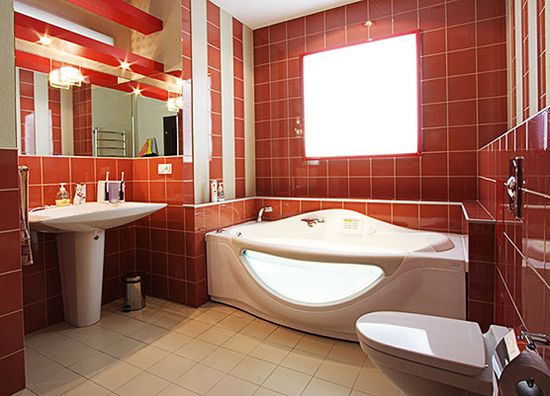
No less common is the Art Nouveau style, characterized by an abundance of bright colors and contrasting combinations
- Bathroom in the style of minimalism, characterized by an abundance of free space, a minimum of furniture and plumbing. In this style of interior there are a lot of clear lines with right angles, the furniture does not have rounded shapes. The colors for the design of the bathroom are selected uniform, it is unacceptable to use more than two shades.

5
- The Japanese style in the interior implies the environmental friendliness of the materials used (silk, wood, rice paper). Tiles are selected with Japanese motifs or ornaments (pagodas, birds, flowers). Such a room is thought out to the smallest detail, but not elaborate and concise. A note of romance will be made from colored glass fixtures. Curtains on the windows with ethnic Japanese ornaments, hieroglyphs or drawings will complete the ensemble.

4
- Loft-style bathroom is one of the most common styles in the interiors of not only living rooms, but also bathrooms. Usually, one or two shades (white or white with an admixture of black) are used to decorate the room. A characteristic detail of the loft style: masonry made of concrete or brick, their imitation or mosaic made of natural stone is possible. The bathroom is complemented by accessories made of glass, chrome, metal, and ceramics.
Small bathrooms




